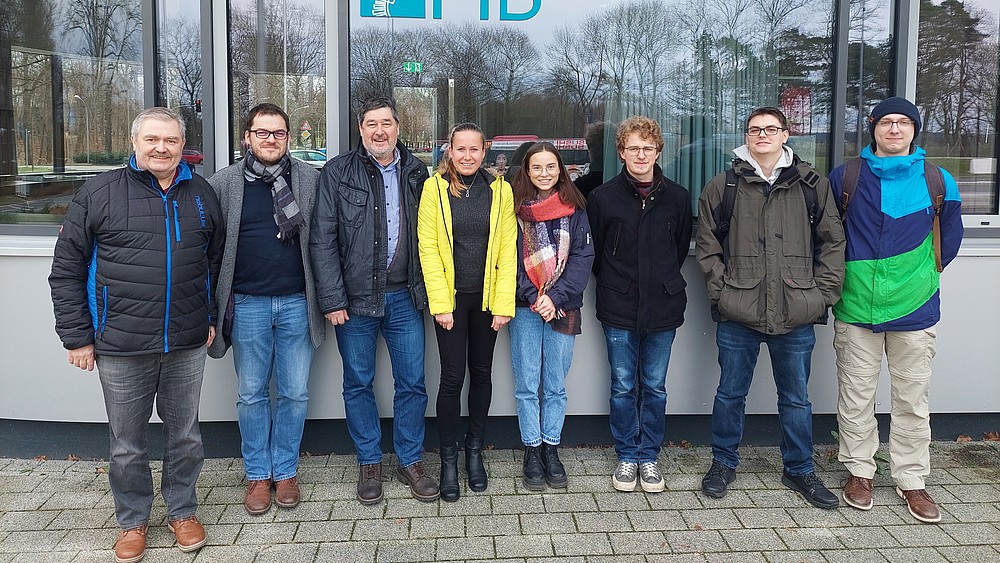In January, the radiation technology team visited the Physikalisch Technische Bundesanstalt and the Asse II mine.

The radiation technology team from the energy and environmental engineering degree program on an excursion! On January 19, we all met at the library in Zittau at 6:45 a.m. to set off together on the HSZG excursion bus to Braunschweig. We arrived at our first excursion stop, the Physikalisch Technische Bundesanstalt (PTB) in Braunschweig, at around 11:00 a.m. after a journey with short breaks in between. Our first stop there was a visit to the canteen for lunch. This was followed by an introductory lecture on the history of the PTB, which was founded as the Physikalisch Technische Reichsanstalt in Berlin, and its tasks. The transfer of the SI standards to natural constants was also discussed.
As we were ahead of schedule, we were given a spontaneous insight into length measurement technology. Where normally cuboids are measured with high precision using interferometers, an attempt is now being made as part of a research project to measure almost perfect spheres and determine their uncertainties. The aim of this determination is to use the spheres in a 3D coordinate measuring machine as a reference standard. We were amazed at the precision with which length measurements can be carried out at the PTB.
This was followed by guided tours of three special laboratories. In the Schering Building and the high-voltage measurement technology available there, then on to the Geiger Building, where we were informed about the radioactive activity unit, nuclide standards and the possibilities of radiation measurement technology. We paid particular attention to the liquid scintillation measurement of beta emitters and the total energy measurement of a beta decay in order to determine the energy spectrum more precisely. Unfortunately, we were unable to gain an insight into the laboratories for the production and testing of the nuclide standards, although this would have been highly interesting as the place of origin and reference for all standards and sources. Finally, the functioning of the various atomic clocks at the PTB was explained to us and also shown in the laboratory, which define our time and send the time signal to the world via Frankfurt.
After visiting the PTB, we went to the German Youth Hostel in Braunschweig. Everyone moved into their rooms there until they all met up again in the group at around 6 p.m. to explore Braunschweig a little. After a cozy dinner in a rustic restaurant with a wide variety of dishes and topics of conversation, the group returned to the youth hostel, where the evening came to an end.
After breakfast the next morning, we drove to the Federal Company for Final Disposal (BGE) in Remlingen to the information point at the Asse II mine. There, the group learned a lot of interesting facts about the history of the mine as a salt mine, its use as a final repository, in which around 126,000 barrels of radioactive waste were stored, and the current project to prepare the retrieval of the stored materials to an above-ground interim storage facility. The current state of knowledge and work was explained.
After a briefing on how to behave underground, a safety briefing on the use of the self-rescuer and refreshments at lunchtime, we went to the changing rooms to enter the mine. At a speed of 10 m/s, the pit cage then descended to a depth of 490 m in the repository. Once there, a two-hour tour of the mine began. In addition to the ventilation system and the vehicle workshop, there were also caverns to see, which show continuous water ingress. Due to the age of the facility, it is necessary in many places to stabilize the chambers and paths with Sorelbeton, a special salt concrete. This serves to secure the facility until the planned retrieval, which is scheduled to begin in 2033. Exiting the mine is only possible on the hour, so the group reached the surface again shortly after 4 pm. Any further questions that arose were answered by the BGE employee responsible during a short debriefing. The group then returned to Zittau at 16:45.
The conclusion of all excursion participants was positive. The visit to the Asse II mine was undoubtedly the highlight of the excursion; it was not only interesting, but also exciting and impressive. The visit to the PTB was interesting, but not so tangible and somewhat remote for us due to the PTB's basic tasks.